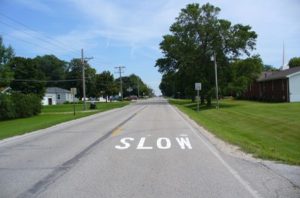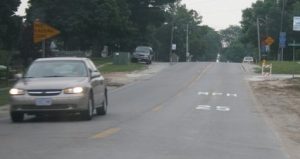Pavement Markings: Legends
Use of wording on the pavement surface is more dramatic than only using signing, which can get lost in the clutter of a streetscape.

Some communities paint the speed limit on the roadway to remind drivers of the speed limit or to indicate a transition zone. In other cases, the word SLOW or SCHOOL is used. Use of wording on the pavement surface is more dramatic than only using signing, which can get lost in the clutter of a streetscape.
No guidance was found on exactly where on-pavement markings should be placed. However, it is assumed that speed-limit legends would be placed on the pavement in the same locations as speed limit signs.
Advantages
- Inexpensive
- Can be implemented rapidly
- No increase in noise
- No impact to emergency vehicles
- No adverse effect on vehicle operations

Disadvantages
- Maintenance
- Less effective in winter
- Can present problems for bicycles and motorcycles
Effectiveness
A study by Hallmark et al. (2007) showed that the use of SLOW pavement markings did not appear to be effective. Use of pavement markings does not affect vehicle operation and is appropriate for use along major roads through small communities.
Cost
The City of Winston-Salem, North Carolina (2005) indicated a cost of $25 to $50 per letter or number and $100 to $200 per symbol.
References
City of Winston-Salem. “Traffic Calming Policy. Section IV.” Traffic Calming Measures, City of Winston-Salem, North Carolina, 2003.
Hallmark, Shauna, Eric Peterson, Eric Fitzsimmons, Neal Hawkins, Jon Resler, and Tom Welch. Evaluation of Gateway and Low-Cost Traffic-Calming Treatments for Major Routes in Small Rural Communities. Center for Transportation Research and Education, Iowa State University, 2007.
